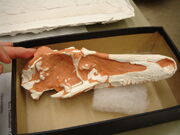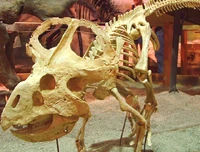| Type | Geological formation |
| Age | Late Cretaceous (late Santonian?–early Campanian) |
| Lithology | |
| Primary | Sandstone |
| Location | |
| Region | Asia |
The Djadochta Formation (sometimes transcribed Djadokhta) is situated in central Asia (Gobi Desert) and dates from the Late Cretaceous Period. Laid down in the early Campanian, possibly starting in the latest Santonian, it is dated somewhat uncertainly at about 84-75 mya (million years ago). The type locality are the famous "Flaming Cliffs", locally known as Bayanzag ("rich in Haloxylon") or Ulaan-Ereg ("red cliffs").
It preserves an arid habitat of sand dunes, with little freshwater apart from oases and arroyos. In fact, the present-day climate at most Djadochta Formation sites differs little from what it was some 80 Ma, except by being somewhat warmer and perhaps a bit less arid then. This is testimony to the fact that the location has long been so far from any major source of evaporation that little rainfall reached it, even before the Himalayas were uplifted which bar clouds from reaching today's Gobi desert.
Most notable fossil discoveries have been the first confirmed dinosaur eggs (a clutch, probably of Oviraptor) and several dinosaur finds, Protoceratops, Pinacosaurus and Velociraptor being the most prominent.
The Djadochta Formation (sometimes transcribed Djadokhta) is situated in central Asia (Gobi Desert) and dates from the Late Cretaceous Period. Laid down in the early Campanian, possibly starting in the latest Santonian, it is dated somewhat uncertainly at about 84-75 mya (million years ago). The type locality are the famous "Flaming Cliffs", locally known as Bayanzag ("rich in Haloxylon") or Ulaan-Ereg ("red cliffs").
It preserves an arid habitat of sand dunes, with little freshwater apart from oases and arroyos. In fact, the present-day climate at most Djadochta Formation sites differs little from what it was some 80 mya, except by being somewhat warmer and perhaps a bit less arid then. This is testimony to the fact that the location has long been so far from any major source of evaporation that little rainfall reached it, even before the Himalayas were uplifted which bar clouds from reaching today's Gobi desert.
Most notable fossil discoveries have been the first confirmed dinosaur eggs (a clutch, probably of Oviraptor) and several dinosaur finds, Protoceratops, Pinacosaurus and Velociraptor being the most prominent.
Flora and fauna[]
The fauna of the Djadochta Formation is very similar in composition to the nearby Bayan Mandahu Formation. The two share many of the same genera, but differ in the exact species. For example, the most common mammal in the Djadochta is Kryptobaatar dashzevegi, while in the Bayan Mandahu, it is the closely related Kryptobaatar mandahuensis. Similarly, the dinosaur fauna of the Djadochta includes Protoceratops andrewsi and Velociraptor mongoliensis, which the Bayan Mandahu yields Protoceratops hellenikorhinus and Velociraptor osmolskae.[1]
Amphibians[]
| Amphibians of the Djadochta Formation | ||||
|---|---|---|---|---|
| Taxa | Presence | Description | Images | |
|
A frog of uncertain classification. | |||
Birds and other theropods[]
| Theropod dinosaurs of the Djadochta Formation | ||||
|---|---|---|---|---|
| Taxa | Presence | Description | Images | |
|
A basal ornithurine bird.[2] |
  | ||
|
A coelurosaur of uncertain relationships. | |||
| An oviraptorid found brooding its eggs. | ||||
|
An oviraptorid with a distinctive, tall crest. | |||
| An oviraptorid. | ||||
| An alvarezsaurid. | ||||
| A dromaeosaurid. | ||||
| May also be present in the Bayan Mandahu Formation. | An oviraptorid. | |||
| Also present in the Bayan Mandahu Formation. | A troodontid. | |||
| An alvarezsaurid. | ||||
|
A tyrannosaur. | |||
|
A dromaeosaurid. | |||
| Also present in the Bayan Mandahu Formation. | A dromaeosaurid. | |||
Crocodylomorphs[]
| Crocodylomorphs of the Djadochta Formation | ||||
|---|---|---|---|---|
| Taxa | Presence | Description | Images | |
| A gobisuchid. | ||||
|
A mesoeucrocodylian. | |||
| A gobisuchid. | ||||
| A basal crocodyliform. | ||||
Lizards[]
| Lizards of the Djadochta Formation | ||||
|---|---|---|---|---|
| Taxa | Presence | Description | Images | |
|
A primitive iguanid. | |||
| An anguimorph. | ||||
|
An anguimorph. | |||
|
An agamid. | |||
|
An agamid. | |||
|
An agamid. | |||
|
A primitive iguanid. | |||
|
||||
Mammals[]
| Mammals of the Djadochta Formation | ||||
|---|---|---|---|---|
| Taxa | Presence | Description | Images | |
|
A marsupial. | |||
| A marsupial. | ||||
|
A marsupial. | |||
|
A therian mammal of uncertain classification. | |||
| A multituberculate. | ||||
| Also present in the Bayan Mandahu Formation. | A placental. | |||
|
A multituberculate, the most common mammal in this formation.[1] | |||
| A placental. | ||||
Ornithischians[]
| Ornithischian dinosaurs of the Djadochta Formation | ||||
|---|---|---|---|---|
| Taxa | Presence | Description | Images | |
|
A hadrosaur of uncertain classification. | |||
| An ankylosaur. | ||||
| A ceratopsian. | ||||
Sauropods[]
| Sauropod dinosaurs of the Djadochta Formation | ||||
|---|---|---|---|---|
| Taxa | Presence | Description | Images | |
|
A sauropod of uncertain classification. | |||
See also[]
- Barun Goyot Formation
- List of fossil sites (with link directory)
- Nemegt Formation
- List of dinosaur-bearing rock formations
Footnotes[]

